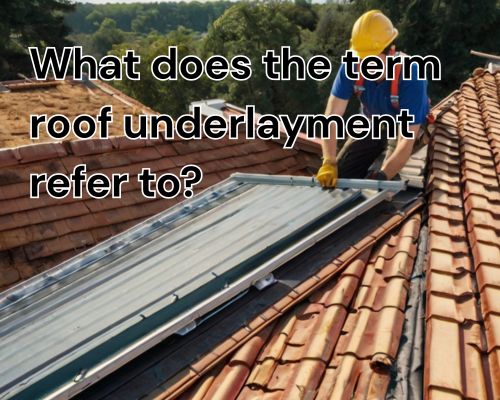If you’re a homeowner in West Palm Beach, Florida, you’ve probably heard your roofing contractor mention “roof underlayment” at some point—perhaps while prepping for a hurricane season upgrade or replacing aged shingles under the relentless South Florida sun. But what does the term roof underlayment refer to, exactly?

With David Spade of Star Roofing, let’s break it down with precision, a bit of local flair, and a whole lot of insight. Because understanding what’s beneath your roof might just be the key to protecting everything under it.
What Is Roof Underlayment?
Roof underlayment is the protective layer installed between your roof deck and the outer roofing material, such as shingles, tile, or metal panels. While it might seem like an invisible component, this layer plays a critical role in waterproofing and weather protection.
In Florida—especially in high-moisture coastal areas like West Palm Beach—this is not a feature you want to skimp on.
Salient Entities & LSI Keywords:
- Roof deck
- Asphalt shingles
- Peel-and-stick underlayment
- Synthetic roofing membrane
- Wind uplift protection
- Secondary water barrier
- Florida Building Code
- Roof inspection
- Hurricane mitigation
Why Is Roof Underlayment Essential in West Palm Beach?
With the city’s tropical rainforest climate, West Palm Beach homeowners face a one-two punch of intense UV radiation and frequent torrential downpours. Not to mention the very real threat of hurricanes during storm season.
Underlayment provides secondary protection against moisture intrusion in case the top roofing material is damaged or lifted due to strong winds. It’s essentially your roof’s backup plan—especially important in areas with high wind uplift zones, like those found across Palm Beach County.
Local Relevance:
Florida’s Statewide Building Code, especially the HVHZ (High-Velocity Hurricane Zone) provisions, requires enhanced roofing systems. West Palm Beach sits near the HVHZ threshold, which means many roofing systems here must include upgraded underlayments like self-adhered membranes or double-layered synthetic products.
Types of Roof Underlayment Used in Florida
Roof underlayment comes in several types, each offering different benefits, especially when tailored for the humid, salt-air-laden environment of coastal Florida.
1. Asphalt-Saturated Felt (Felt Paper)
Once the industry standard, this “old-school” material still has its uses. It’s economical and water-resistant—but less effective in humid climates. In West Palm, it’s often used in budget-conscious repairs or under less demanding conditions.
2. Synthetic Underlayment
Lightweight, durable, and resistant to mold and UV damage, synthetic membranes have become the go-to underlayment for new roof installations across West Palm Beach. Products like Tyvek Roof Protector or GAF Deck-Armor™ are popular for their high tensile strength and ease of installation.
3. Rubberized Asphalt (Peel-and-Stick)
This is the gold standard in coastal environments. With adhesive backing and self-sealing properties, it’s ideal for hurricane-prone zones. Homeowners upgrading to metal roofs or clay tile systems often opt for this option due to its superior waterproofing.
Common Roof Systems in West Palm Beach
The type of underlayment you choose is often dictated by the type of roofing material you install. Here’s how underlayment pairs with the popular roof styles in our area:
- Clay Tile Roofs: Popular for their Mediterranean aesthetic and heat resistance, these require premium underlayment due to their long lifespan and heavier weight.
- Metal Roofs: Increasingly used in hurricane mitigation retrofits. Here, a rubberized peel-and-stick underlayment is often recommended.
- Asphalt Shingles: Still common in residential developments. A synthetic underlayment paired with architectural shingles offers a solid, cost-effective solution.
Roof Underlayment and Florida Code Compliance
Florida doesn’t mess around when it comes to roof integrity. Whether you’re dealing with the Florida Building Code (FBC) or your insurance company, underlayment choices can influence:
- Insurance eligibility and premiums
- Roof replacement permitting
- Wind mitigation credits
- Post-storm inspection approvals
In fact, Florida Statute 553.844 outlines underlayment specifications to improve resistance to water intrusion after shingle loss. Knowing your options isn’t just smart—it’s legally relevant.
How Long Does Roof Underlayment Last?
The lifespan of underlayment depends on the type and installation quality. Here’s a general guideline:
- Asphalt Felt: 10-15 years
- Synthetic: 25-30 years
- Peel-and-Stick: 30-40 years
However, given West Palm Beach’s high humidity, salt exposure, and storm threats, real-world durability might lean toward the lower end—unless properly maintained.
Pro Tip:
Always ask your roofer if they’re using FBC-compliant materials, and whether they’re installing underlayment with drip edge flashing—a small detail with big impact on water shedding.
When Should You Replace Your Roof Underlayment?
Roof underlayment is typically replaced during a full roof replacement—or if there’s storm damage that penetrates below the top layer. Warning signs include:
- Water leaks in the attic after storms
- Visible sagging or moisture in decking
- Shingle loss after strong winds
- Insurance inspection requiring upgrades
For homeowners in West Palm Beach, it’s wise to schedule a roof inspection every 2-3 years, particularly after major weather events. Local companies like Star Roofing and Palm Beach Roof Pros often provide free evaluations post-hurricane.
Final Thoughts: Why It Matters
So, what does the term roof underlayment refer to?
It refers to the invisible armor that guards your home against moisture, wind, and decay. It’s the unsung hero of roofing systems—especially vital in regions like West Palm Beach, Florida, where nature pulls no punches.
Choosing the right underlayment isn’t just a technical decision—it’s a strategic investment in your property’s longevity, value, and resilience.
Call to Action: Don’t Just Cover—Protect!
If your roof is more than 15 years old or you’re unsure about your current underlayment, get a free inspection from a certified local roofer. Ask about synthetic vs. peel-and-stick, and make sure your home meets or exceeds Florida Building Code standards.